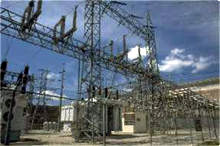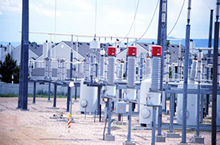After the power has reached its general
destination along the high-voltage line, it is converted to a lower voltage
at a transformer station. This is usually done by the Local Distribution Company
(LDC), or Municipal Distribution Company (MUNI). Each state and province
has anywhere from one, to over fifty of these distribution companies that
deal with delivering the power to the retail, commercial and industrial user.
They build, own and operate the local wires, and handle metering, billing
and payment. In most states and provinces, these organizations are regulated
by the Public Utility Commissions (PUC).
| If you keep an eye out in your neighbourhood,
you’ll probably be able to spot the transformer yard (like the ones in
these photos). |
 |
 |
|
Transformer
yards
|
 |
This is where the high voltage power
lines meet the low voltage lines that eventually come into your home.
The high voltage wires are hooked up to a transformer (like in this photo),
which converts the power to a lower voltage. |
|
Transformer
|
|
|
|
Then this medium voltage electricity is distributed
through a municipal grid to each street (see photo of medium voltage power
lines). |
|
Medium voltage power line
|
|
|
|
On each street (and sometimes at more
than one location per street) the medium voltage electricity is stepped-down
by a local transformer. You should be able to find one of these on your
street (unless you live is a very new sub-division where they are sometime
placed underground – look for a green metal box). |
|
Pole-mounted Transformer
|
|
|
|
From this
pole-mounted transformer, wires lead directly into your home breaker panel. |
|
Domestic Breaker Panel
|
|
Now that we’ve traced the path that the electricity takes
from the generating station all the way into your home, let’s take a look
at the regulatory bodies that are responsible for ensuring continuous and
reliable electricity flow. |